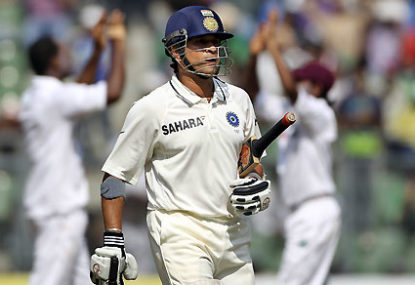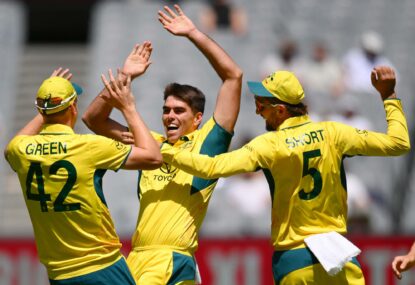The SCG is the greatest of all the cricket grounds throughout the world. The prestige of the ground will obviously be enhanced if Sachin Tendulkar, The Little Master, scores his century of 100s in international cricket during the Sydney Test that starts on Tuesday.
But it is also true to say that if Tendulkar scores a century during the Test that this event will be given a golden gloss, in cricket terms, by being scored home ground in first class cricket of Victor Trumper and the young Don Bradman.
Why do I make the claim for the SCG being the greatest cricket ground of them all?
Lord’s with 123 Tests and the Melbourne Cricket Ground with 104 have played host to more Tests than the SCG with its 99 Tests since 1882. But this is a numerical calculation only. It is like saying a person has a more mellifluous name than someone else because he has more letters in it.
Lord’s is a small, rather cramped ground, except for the new-age and bizarre media section which looks like an UFO ready for lift-off. The pitch is not level, with a distinct slope at one end. Admittedly, the ghosts of great cricketers from ‘my Hornby and Barlow of so long ago’ hover in the shadows. But the Lord’s atmosphere does not match the sun-lit fizz and crackle of the SCG during an intense Test match.
As for the MCG, it is a ground that can only be loved by the locals. It is vast, as a field and from the perspective of spectators. There is none of the intimacy and the sense of tradition in terms of its stands at the MCG that you get at the SCG with its lovely Ladies and Members Stands which hark back to the early days of the game when Tests were social occasions, almost as much as sporting occasions.
You went to the SCG to see the play and to be seen. Even now this sense that the SCG is a theatre that allows Sydney to be at play and to revel in the play is still very real.
The newish Trumper stand, for instance, is a magnificent viewing space that provides such outstanding sight lines you feel as if you are on the ground itself. And if you go into one of the urinals, as I did in a Test a year or so ago, you will find you watch the game from a slit window at eye level while performing a necessary task.
This sense of the ground being a theatre for the players and the spectators is enhanced with a realistic bronze statue of Stephen Gasgoigne, Yabba, sitting on the first row at the fence in front of the Trumper Stand in a position he took over as his territory and soap box on the then Hill section of the ground. It was from this spot that Yabba spotted the stiff-backed, priggish, Harlequin cap-wearing England captain Douglas Jardine, the villian of the Bodyline Series, brushing away some flies.
‘Oi, Jardin, leave our flies alone,’ he bellowed out. ‘They’re the only flamin’ friends you’ve got here.’
What other sports ground has honoured a spectator (admittedly its most colourful) and through him all the millions of spectators who have enjoyed the SCG since the ground came into existence in 1852 in this way?
This gesture by the SCG Trust of the Yabba statue, which was pushed hard by its knowledgeable, brilliant and effective chairman Rodney Cavalier, to my mind exemplifies the magic of the SCG. It is a ground that inspires a passionate love from the players who honour its traditions and from the spectators who honour the players.
I’d like to be a bit indulgent at this point and bring in some personal memories of the ground. As a youngster growing up in New Zealand the cricket season really started for me when the Tests in Australia began and the voice of the commentators like Alan McGilvray and the masterful summing-up expert Johnny Moyes crackled through the big radio in my parent’s front room.
It seemed to me in those days that all the Tests were played at the SCG. I am sure this was the perception that youngsters like me all around the world, in South Africa, India and England felt, too. I could never get a consciousness of the other Test grounds in Australia. The SCG and the Sydney Tests were imprinted in my memory as treasured memories.
So when I came to Sydney for the first time, to watch an Ashes Test at the SCG, I asked the taxi driver taking me to a grotty hotel by Central Station to stop at the SCG. He did this. I jumped out of the car and rushed through the open gates and made my way to the ground.
The stands were empty and there were several ground staff prodding around the Test pitch. For me, though, it was a transcendental moment. I was standing at the sacred site of world cricket. I reckon I could see, if only in the mind’s eyes, all the great players of the past as they performed their heroic deeds in front of vast crowds. I had my feet on turf graced by Trumper, Hill, Hobbes, Bradman, Pomsford, Hammond, Morris, Harvey, Miller …
I spent the Test on the Hill and enjoyed the chatter, the drinking and the energy the spectators invested in their efforts to enjoy the game. It helped matters in this respect that the great Alan Davidson was in fine form rattling through the England batting lineup as if their bats were made of plywood.
Australia won the Test which reminds me of another characteristic of the SCG, and another reason why it is the champion of cricket grounds. The SCG is a result ground. The pitch has enough in it for bowlers (in past favourable for spinners) to take 20 wickets in the allotted time-frame. But the comfortable boundaries, challenging for six hitting but amenable for fours, allow the batsmen to score quickly when they are set. This makes for interesting cricket and results. Of the last 18 Tests, for instance, only one has finished in a draw. The last 8 Tests have all ended with a winner.
My experience of the drama and excitement of a Test at the SCG has been enjoyed by millions of spectators over the decades. The SCG Trust publishes a splendid diary for members for which the sports historian and journalist Phil Derriman writes pieces about the ground’s history related to the date. This is another alluring example of the Trust’s dedication to honouring its ground by preserving its memories. In front of me is a typical piece I’ve kept about Banjo Paterson’s experience as an SCG member.
He was accepted as a member as a 21-year-old in 1885. Typically, he remained a member all his life. As a teenager, six years earlier, he invaded the SCG during the famous (Derriman calls it the ‘infamous’) Lord Harris Riot. This riot has been described by sports historians as a seminal moment in changing the perception that Australia was merely a satellite (or, worse, a serf) of ‘the mother country.’
In a way, Paterson and the other hot-bloods who ran on to the SCG were part of the human chain of spectators who helped the create the environment for Yabba to flourish.
Anyway, Paterson, like Yabba, loved the SCG. Derriman records a fine quote from Paterson where he recalled ‘many a Saturday afternoon I paid my shilling and sat on the Hill … Breathes there man with soul so dead that he never heard of the Sydney Cricket Ground.’
From a host of memories, some of them involving sports other than cricket (for the SCG has hosted a great variety of sporting events), my single favourite moment was being at the ground when the Bradman and O’Reilly Stands were officially opened. The two great men came out to the middle. There was a warm reception from the crowd, some of them (I know I was) teary-eyed at the nostalgia and history of the moment. Bradman picked up a stump and demonstrated a flowing drive with it for the photographers. After the ceremony, O’Reilly put his arm around his old captain, and for a moment old enemities were forgotten. It was just two warriors from a time past, Australia’s greatest batsmen and greatest bowler, walking off the ground they had created cricket legends on.
In the lead-up to the SCG’s century of Tests and Tendulkar’s (hopefully) century of international tons, there have been many articles about the great deeds achieved in Tests at the ground: Victor Trumper’s 185 not out in four hours in 1903, Stan McCabe’s 187 not out against the venom of Bodyline bowling, Steve Waugh’s dramatic last-ball 4 to achieve his last Test century in 2003 … There are literally hundreds of special moments like this in the SCG’s Test archive.
Contemplating these highlights brings us back to Sachie Tendulkar and the SCG. The Little Master has a batting average of 221.34 at the ground, the highest of any Test player. His run of scores at the ground is Bradmanesque: 148 not out in his first appearance 20 years ago, 45, 4, 241 not out, 60 not out, 154 not out and 12.
Here is what he says about the SCG: ‘The SCG has obviously been one of my favourite grounds away from India. It’s a terrific ground, a special place and I love the atmosphere inside. It’s wonderful … It’s a fantastic atmosphere.’
Neville Cardus, the outstanding if florid cricket writer of the 1920s to the 1950s, once noted that as a child when England was playing Australia he’d pray that Victor Trumper would score a century but that England would still win. I think a similar prayer is in order this week: ‘Please God, let Sachin Tendulkar score a century and Australia win the Test.’





































































































